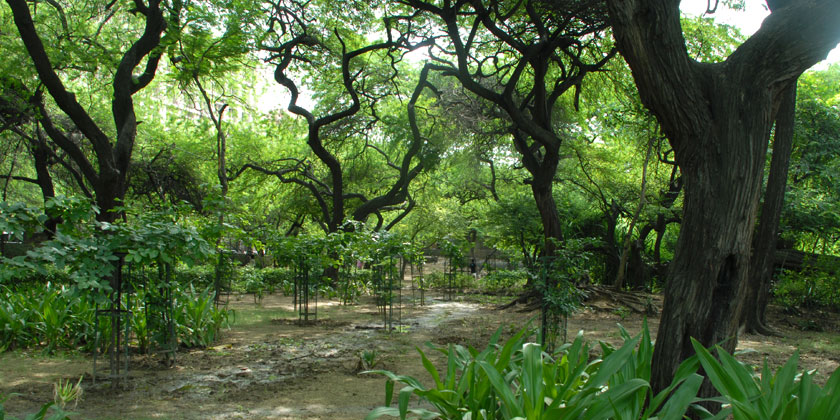Kamla Nehru Biodiversity Park

The Northern Ridge (Kamla Nehru Ridge) spreads across 122.00 hectares near Delhi University, north Campus. Based on the topographical features and the divides formed by public roads that pass through the Ridge, the Northern Ridgeis divided into 6 segments (zones).
The Ridge is highly weathered resulting in undulating topography with many high and low points. Consequently, the Ridge has flat hill tops, shallow valleys and gentle slopes. The Ridge is fragmented due to City Roads that traverses through the Ridge in criss cross manner and infested by a Mexican weed- Prosopis juliflora, commonly known as Kabuli Kikar or Vilayati Kikar, which was introduced by British Colonial Government for greening the Ridge. Within 150 years of introduction on the Ridge it has eliminated many native plant and animal species. The major objective is to bring back the pristine native forest communities of Aravalli Hill Ranges that once thrived in the Ridge. Canopy Opening method and cut rootstock method have been used for the management of Prosopis juliflora. To allow the saplings planted to grow, small canopy gaps have been created by pruning dead branchlets of the invasive alien Prosopis juliflora, which as per International Conventions, and recommendations of FAO, has to be eradicated. Lantana, another noxious alien species, which is being eradicated from protected areas, has been removed to create space on the ground. With opening of the canopy, native plants get abundant sunlight for their growth and survival and slowly they out-compete the Prosopis juliflora.
The approach involving the creation of small canopy gaps and removal of weedy species from the ground for allowing the growth of saplings of native tree species is novel and simulates the natural ecological succession process, the end product of which is the original ecosystems. Restoration of biodiversity at KNR has started with re-introduction of various plant species that once existed here. This includes various species of herbs, shrubs, trees and grasses. So far, total 9876 native plants have been planted at KNR.
The hill-tops and slopes with boulders are being developed into Tropical Dry Deciduous Forest with species such as Acacia senegal, Acacia catechu, Acacia modesta, Prosopis cineraria, Holoptelia integrifolia, Lannea coromandelica, Sterculia urens, Butea monosperma, Nyctanthus arbor-tristis, Wrightia tinctoria, Aegle marmelos and Cassia fistula.
Some of the ditches where moisture is abundant are planted with Mixed Dry Deciduous Forest species such as Bauhinia variegata, Albizia lebbeck, Syzygium cumini, Emblica officinalis, Mitragyna parviflora, Terminalia belerica, Terminalia arjuna, Terminalia tomentosa, Erythrina indica, Ficus racemosa, Ficus virens etc. Some of the areas have been vegetated with Anogeissus Dominated Community species such as Anogeissus pendula, Anogeissus sericea along with Wrightia tinctoria, Cassia fistula, Ficus virens etc. The areas all along the boundary wall of the KNR have been planted with bamboo- Dendrocalamus strictus. During the monsoon, seeds of Cenchrus ciliaris have been broadcasted to enrich and extend the grass cover.
Rainwater Harvesting and Recharging Aquifers For harvesting rainwater, channels have been dug up to direct rain water into various recharging pits and depressions. To capture surface run-off and prevent rainwater from escaping into surrounding areas, various culverts have been constructed. Further, there are five water bodies located in Northern Ridge, which act as a water recharge point. Channels have also been constructed for directing rain water into these water bodies.
Biodiversity profile 87 native plant species, 64 bird species, 7 species of mammals, 3 species of amphibians and 31 species of butterflies have been recorded.
